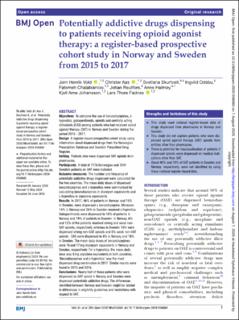| dc.contributor.author | Vold, Jørn Henrik | |
| dc.contributor.author | Aas, Christer Frode | |
| dc.contributor.author | Skurtveit, Svetlana | |
| dc.contributor.author | Odsbu, Ingvild | |
| dc.contributor.author | Chalabianloo, Fatemeh | |
| dc.contributor.author | Reutfors, Johan | |
| dc.contributor.author | Halmøy, Anne | |
| dc.contributor.author | Johansson, Kjell Arne | |
| dc.contributor.author | Fadnes, Lars T. | |
| dc.date.accessioned | 2021-03-26T13:47:29Z | |
| dc.date.available | 2021-03-26T13:47:29Z | |
| dc.date.created | 2020-10-20T12:43:12Z | |
| dc.date.issued | 2020 | |
| dc.Published | BMJ Open. 2020, 10 . | |
| dc.identifier.issn | 2044-6055 | |
| dc.identifier.uri | https://hdl.handle.net/11250/2735771 | |
| dc.description.abstract | Objectives: To compare the use of benzodiazepines, z-hypnotics, gabapentinoids, opioids and centrally acting stimulants (CAS) among patients who had received opioid agonist therapy (OAT) in Norway and Sweden during the period 2015 - 2017.
Design: A register-based prospective cohort study using information about dispensed drugs from the Norwegian Prescription Database and Swedish Prescribed Drug Register.
Setting: Patients who were dispensed OAT opioids from pharmacies.
Participants: A total of 7176 Norwegian and 3591 Swedish patients on OAT were included.
Outcome measures: The number and frequency of potentially addictive drugs dispensed were calculated for the two countries. The mean daily doses of dispensed benzodiazepines and z-hypnotics were summarised by calculating benzodiazepines in diazepam equivalents and z-hypnotics in zopiclone equivalents.
Results: In 2017, 46% of patients in Norway, and 15% in Sweden, were dispensed a benzodiazepine. Moreover, 14% in Norway and 26% in Sweden received z-hypnotics. Gabapentinoids were dispensed to 10% of patients in Norway and 19% of patients in Sweden. In Norway, 6% and 12% of the patients received strong and weak non-OAT opioids, respectively, whereas in Sweden 10% were dispensed strong non-OAT opioids and 5% weak non-OAT opioids . CAS were dispensed to 4% in Norway and 18% in Sweden. The mean daily doses of benzodiazepines were 16 and 17 mg diazepam equivalents in Norway and Sweden, respectively. For z-hypnotics, the mean daily dose was 8 mg zopiclone equivalents in both countries. ‘Benzodiazepines and z-hypnotics’ was the most dispensed drug combination in 2017. Similar results were found in 2015 and 2016.
Conclusions: Nearly half of those patients who were dispensed an OAT opioid in Norway and Sweden were dispensed potentially addictive drugs. The differences identified between Norway and Sweden might be related to differences in eligibility guidelines and restrictions with respect to OAT. | en_US |
| dc.language.iso | eng | en_US |
| dc.publisher | BMJ Publishing Group | en_US |
| dc.rights | Navngivelse-Ikkekommersiell 4.0 Internasjonal | * |
| dc.rights.uri | http://creativecommons.org/licenses/by-nc/4.0/deed.no | * |
| dc.title | Potentially addictive drugs dispensing to patients receiving opioid agonist therapy: a register-based prospective cohort study in Norway and Sweden from 2015 to 2017 | en_US |
| dc.type | Journal article | en_US |
| dc.type | Peer reviewed | en_US |
| dc.description.version | publishedVersion | en_US |
| dc.rights.holder | © Author(s) (or their employer(s)) 2020. | en_US |
| dc.source.articlenumber | e036860 | en_US |
| cristin.ispublished | true | |
| cristin.fulltext | original | |
| cristin.qualitycode | 1 | |
| dc.identifier.doi | 10.1136/bmjopen-2020-036860 | |
| dc.identifier.cristin | 1840862 | |
| dc.source.journal | BMJ Open | en_US |
| dc.source.40 | 10 | |
| dc.identifier.citation | BMJ Open, 2020, 10 (8), e036860 | en_US |
| dc.source.volume | 10 | en_US |
| dc.source.issue | 8 | en_US |

